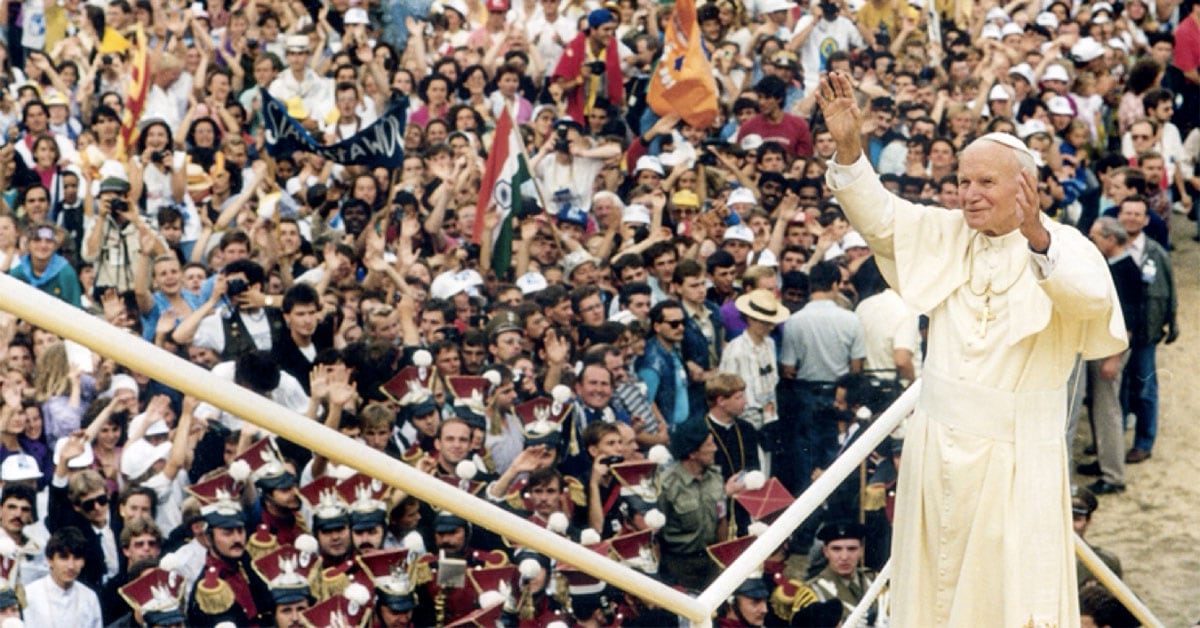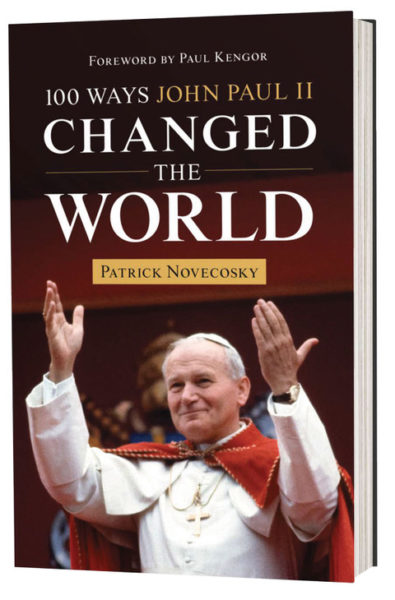
(April 2, 2020) — Fifteen years ago Thursday, the world bid farewell to a tenacious world leader whose life and words have much to offer us today. Even though Pope Saint John Paul II didn’t live through a global pandemic, he was renowned for his fighting spirit and his ability to find hope in troubled times. He found that hope in the cross of Jesus Christ.
As a young man, he survived the Nazi occupation of his homeland before serving the church in Poland as a priest and bishop during the communist occupation of Eastern Europe — until he eventually helped engineer its downfall.
When he died on April 2, 2005, at age 84, the Polish pope had guided the Catholic Church for more than 26 years. His life and his death spoke of his unfading hope in God’s providence and his mercy on all who turn their hearts heavenward.
What would John Paul say to today’s world, filled with so much uncertainty amid this global pandemic? There’s no way to know for sure, but when he spoke to global leaders at the United Nations in 1995, he told them to “be not afraid,” the mantra he repeated often throughout his pontificate.
“We must overcome our fear of the future,” the pope said. “But we will not be able to overcome it completely unless we do so together. The answer to that fear is neither coercion nor repression, nor the imposition of one social model on the entire world. The answer to the fear which darkens human existence at the end of the twentieth century is the common effort to build the civilization of love, founded on the universal values of peace, solidarity, justice, and liberty.”
If there was ever a man who had a right to embrace pessimism, it was Karol Wojtyla. Born in Wadowice, Poland, in 1920, the man who would go on to become John Paul II lived a life of suffering.
Young Karol was almost 9 when his mother Emilia died. Three years later, his brother Edmund, a doctor, contracted scarlet fever during an outbreak and died at the age of 26. Before the future pope had turned 21, his father died, leaving him an orphan.
The pope’s suffering was deepened in 1981 when an assassin shot him in St. Peter’s Square. Although his mental acuity never waned, his physical health began to decline with each successive year after breaking his leg in 1994.
Instead of turning inward as a pessimist and allowing his circumstances dictate his response, John Paul turned to God in prayer. This was, in a sense, the nuclear reactor that powered his entire life and all that he accomplished as a priest, bishop, pope, philosopher, theologian, poet, and diplomat.
“Although I have lived through much darkness, under harsh totalitarian regimes, I have seen enough evidence to be unshakably convinced that no difficulty, no fear is so great that it can completely suffocate the hope that springs eternal in the hearts of the young,” he said at the 2002 World Youth Day in Toronto. “Do not let that hope die! Stake your lives on it! We are not the sum of our weaknesses and failures; we are the sum of the Father’s love for us and our real capacity to become the image of his Son.”
As I document in my new book, John Paul saw his role as more than just the leader of the world’s 1.2 billion Catholics. He firmly believed that God had positioned him to be pastor to the world. All told, the Polish pontiff made 104 foreign trips, touching down in 129 countries. He logged more than 775,000 miles — the equivalent of circling the globe more than 30 times.
John Paul II reached out to men and women of all faiths — and those without religious conviction. He called the new atheism “the spiritual tragedy of our times,” and he entered into serious dialogue with all Christians — from evangelicals to traditional Protestants, from Orthodox churches to fallen-away Catholics.
In fact, shortly before his election as pope, Cardinal Wojtyla gave permission for Billy Graham to preach at St. Ann’s Catholic Church in Krakow. A few years later, during Billy Graham’s first meeting with John Paul II in 1981, the pope held the American evangelist’s hand and said: “We are brothers.” For the Holy Father, that was one of many victories in his efforts to bring Christians together.
 As the world watched John Paul’s rapidly declining health during the early months of 2005, the pope’s suffering was on full display. When he appeared at the window of the papal apartments on Easter Sunday, he was barely able to speak above a whisper. We watched and our hearts were moved. Despite the Easter jubilation, the pope was still walking “the way of the cross.”
As the world watched John Paul’s rapidly declining health during the early months of 2005, the pope’s suffering was on full display. When he appeared at the window of the papal apartments on Easter Sunday, he was barely able to speak above a whisper. We watched and our hearts were moved. Despite the Easter jubilation, the pope was still walking “the way of the cross.”
When he died on April 2 — the eve of Divine Mercy Sunday — tributes poured in from around the globe. Former U.S. Secretary of State Henry Kissinger said: “John Paul II was one of the greatest men of the last century. Perhaps the greatest.”
Billy Graham told talk show host Larry King that the pope dying was like losing a member of his own family.
“He believed in the cross,” Graham said. “That was his focus throughout his ministry, the cross, no matter if you were talking to him from a personal issue or an ethical problem, he felt that there was the answer to all of our problems, the cross and the resurrection.”
Patrick Novecosky is a media relations professional. He lives in Florida with his wife and five children. His new book is “100 Ways John Paul II Changed the World.” This article originally appeared at FoxNew.com on April 2, 2020.



